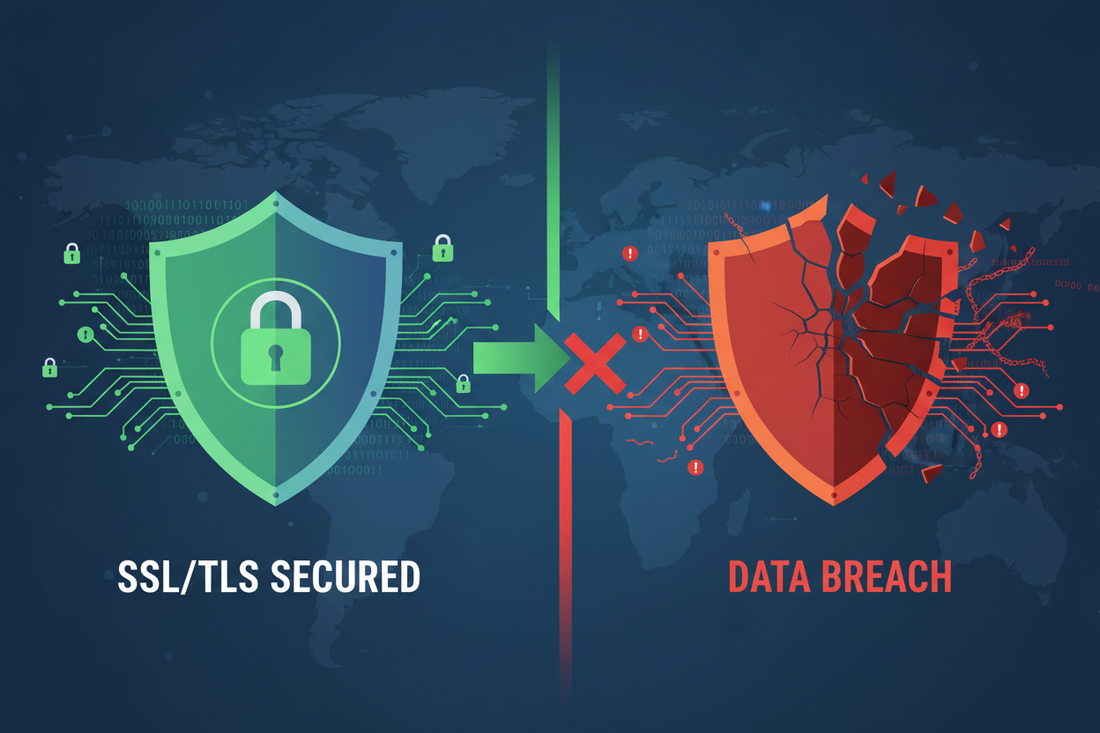
Why Do Major Data Breaches Happen to Companies with SSL Certificates?
Zane LucasShare
High-profile data breaches continue making headlines despite victim organizations prominently displaying SSL Certificate padlocks and security badges on their websites. This apparent contradiction confuses consumers and businesses alike, who reasonably assume that SSL Certificates provide comprehensive protection against cyber attacks. Understanding why breaches occur despite SSL Certificate deployment reveals critical security gaps that organizations must address beyond basic encryption implementation.
The misconception that SSL Certificates alone prevent data breaches creates dangerous security blind spots that criminals actively exploit. While SSL Certificates from providers like Trustico® provide essential encryption for data transmission, they represent just one component of comprehensive security architecture. Organizations suffering breaches despite having SSL Certificates typically failed in other security domains, or implemented SSL Certificates incorrectly, creating vulnerabilities that attackers leveraged for unauthorized access.
Recent breach investigations reveal that improperly configured SSL Certificates, expired SSL Certificates that went unnoticed, and SSL Certificates from questionable providers actually enabled rather than prevented successful attacks. These failures highlight the critical difference between simply having an SSL Certificate and maintaining proper security infrastructure with professional-grade SSL Certificates correctly implemented and actively managed.
Understanding What SSL Certificates Actually Protect
SSL Certificates encrypt data during transmission between web servers and browsers, protecting information from interception during transit. This encryption prevents attackers from reading credit card numbers, passwords, or personal information as it travels across networks. However, SSL Certificates cannot protect data once it reaches its destination, nor can they prevent attacks that don't involve intercepting network traffic.
Database breaches, application vulnerabilities, insider threats, and social engineering attacks bypass SSL encryption entirely by targeting data at rest or exploiting human factors. Major breaches at retail giants and financial institutions occurred through point-of-sale malware, database injections, and compromised credentials that SSL Certificates were never designed to prevent. Understanding these limitations helps organizations implement appropriate complementary security measures.
The visibility of HTTPS and padlock icons creates false confidence that leads organizations to underinvest in other critical security controls. Criminals understand this psychology and specifically target organizations that rely too heavily on SSL Certificates without implementing comprehensive security programs. The presence of SSL encryption actually becomes a liability when it masks underlying security weaknesses.
Configuration Failures That Transform Protection into Vulnerability
Misconfigured SSL Certificates create security vulnerabilities more dangerous than having no SSL Certificates at all, as they provide false assurance while leaving systems exposed. Common configuration errors include failing to install intermediate SSL Certificates, enabling outdated protocols like SSL 3.0 or TLS 1.0, and supporting weak cipher suites that attackers can break. These misconfigurations often result from following outdated documentation or using cheap providers that offer minimal implementation guidance.
Mixed content vulnerabilities occur when websites serve some resources over HTTPS while loading others via unencrypted HTTP connections. Attackers exploit these gaps to inject malicious code or steal session tokens despite the presence of valid SSL Certificates. Professional providers like Trustico® help organizations identify and eliminate these vulnerabilities through comprehensive implementation support and configuration validation.
SSL Certificate pinning failures and improper validation in mobile applications create attack vectors that criminals exploit to intercept supposedly secure communications. Organizations often discover these vulnerabilities only after breaches occur, when forensic analysis reveals that SSL implementation errors enabled the attack. Proper configuration requires expertise that budget SSL Certificate providers rarely offer.
The Expired SSL Certificate Crisis Nobody Discusses
Expired SSL Certificates create immediate security vulnerabilities that attackers monitor and exploit within hours of expiration. Automated scanning tools constantly probe websites for expired SSL Certificates, alerting criminal networks to potential targets. When SSL Certificates expire, browsers may allow users to bypass warnings, creating opportunities for man-in-the-middle attacks that capture sensitive data.
Major breaches have occurred when organizations failed to renew SSL Certificates on internal systems, assuming that private networks didn't require the same security attention as public-facing websites. Attackers who gain initial network access specifically look for expired internal SSL Certificates that enable lateral movement and privilege escalation. These internal SSL Certificate failures often go undetected for months, allowing attackers to establish persistence and exfiltrate data.
SSL Certificate expiration during critical business periods, such as holiday shopping seasons or financial reporting deadlines, forces organizations to choose between security and business continuity. Pressure to maintain operations leads to temporary security bypasses that criminals exploit. Trustico® prevents these scenarios through proactive renewal management and emergency support services.
Fraudulent SSL Certificates and Domain Validation Weaknesses
Cybercriminals routinely obtain legitimate Domain Validation (DV) SSL Certificates for phishing sites and malware distribution servers, exploiting weak validation processes from budget providers. These fraudulent SSL Certificates display the same padlock icons and HTTPS indicators as legitimate sites, deceiving users into trusting malicious websites. The proliferation of cheap DV SSL Certificates has made this attack vector increasingly common.
Subdomain takeover attacks allow criminals to obtain valid SSL Certificates for abandoned subdomains of legitimate organizations, creating convincing phishing sites that bypass security filters. E-mail validation weaknesses enable attackers to obtain SSL Certificates by temporarily controlling e-mail addresses through various technical exploits. These fraudulently obtained SSL Certificates facilitate breaches by establishing trusted communication channels for data exfiltration.
Organization Validation (OV) and Extended Validation (EV) SSL Certificates from Trustico® require rigorous verification that prevents criminals from obtaining SSL Certificates for fraudulent purposes. This validation rigor provides actual security value beyond basic encryption, protecting organizations and their customers from sophisticated phishing attacks.
Supply Chain Attacks Through Trusted SSL Certificates
Modern supply chain attacks exploit the trust relationships established by SSL Certificates between organizations and their vendors, partners, and service providers. Attackers compromise smaller organizations with weak security to obtain valid SSL Certificates, then use these trusted connections to breach larger targets. The presence of valid SSL Certificates actually facilitates these attacks by ensuring encrypted communication channels for data theft.
Third-party scripts and resources loaded from compromised but SSL Certificate-validated domains bypass security controls that trust HTTPS connections. Marketing tags, analytics scripts, and payment processing integrations become attack vectors when criminals compromise these services while maintaining valid SSL Certificates. Organizations unknowingly facilitate their own breaches by trusting external resources based solely on SSL Certificate presence.
Certificate Authority (CA) compromises represent the ultimate supply chain attack, where criminals obtain seemingly valid SSL Certificates by breaching the CA infrastructure itself. Budget providers with weak security controls present attractive targets for nation-state actors and sophisticated criminal groups. Established providers like Trustico® maintain robust security programs that protect the entire SSL Certificate ecosystem.
Internal Threats That SSL Certificates Cannot Address
Insider threats remain responsible for a significant percentage of data breaches, and SSL Certificates provide no protection against authorized users who abuse their access privileges. Employees with legitimate credentials can access and exfiltrate data regardless of encryption status. Malicious insiders specifically exploit the trust that SSL Certificates create, knowing that encrypted connections hide their activities from security monitoring.
Privileged account compromises through phishing, social engineering, or credential stuffing grant attackers legitimate access that bypasses all SSL protections. Once inside the encrypted perimeter, criminals operate with the same privileges as legitimate users. These breaches often persist for months because organizations assume that SSL encryption indicates legitimate activity.
Third-party vendor access through encrypted connections creates additional insider threat vectors that SSL Certificates cannot mitigate. Contractors, consultants, and service providers with valid credentials and encrypted connections can intentionally or accidentally cause breaches. Organizations must implement zero-trust architectures and comprehensive monitoring beyond basic SSL encryption.
Application Layer Attacks That Bypass Encryption
SQL injection, cross-site scripting (XSS), and other application vulnerabilities remain effective despite perfect SSL Certificate implementation. These attacks target application logic flaws rather than network transmission, rendering encryption irrelevant. Attackers actually prefer encrypted channels for these exploits because SSL prevents security tools from inspecting malicious payloads.
Zero-day exploits in popular frameworks, content management systems, and applications provide direct access to backend systems regardless of SSL Certificate presence. Recent breaches through vulnerabilities in WordPress plugins, Magento extensions, and enterprise applications occurred at organizations with valid SSL Certificates properly configured. The encryption simply protected the attackers' command and control communications.
Application programming interface (API) vulnerabilities represent an increasingly common breach vector that SSL Certificates cannot prevent. Poorly secured APIs with valid SSL Certificates provide direct database access to attackers who discover exposed endpoints. The encryption that protects legitimate API traffic equally protects malicious requests that exploit authorization flaws.
The SSL Certificate Management Maturity Gap
Organizations often treat SSL Certificate management as a one-time implementation rather than an ongoing security program requiring continuous attention. This management immaturity creates vulnerabilities through SSL Certificate sprawl, shadow IT SSL Certificates, and inconsistent security policies across different systems. Breaches frequently originate from forgotten SSL Certificates on development servers or test environments that maintain production data access.
Manual SSL Certificate management processes fail to scale with organizational growth, leading to gaps in coverage and expired SSL Certificates on critical systems. Spreadsheet tracking and e-mail reminders prove inadequate for managing hundreds or thousands of SSL Certificates across complex infrastructure. Professional providers like Trustico® offer SSL Certificate management platforms that prevent these operational failures.
The absence of SSL Certificate inventory visibility enables attackers to exploit unknown or forgotten SSL Certificates that organizations don't realize exist. Mergers, acquisitions, and IT staff turnover compound this problem as institutional knowledge about SSL Certificate deployments disappears. Comprehensive SSL Certificate discovery and management prevents these blind spots that attackers exploit.
Compliance Checkbox Mentality Versus Real Security
Organizations that implement SSL Certificates solely for compliance requirements often choose the minimum necessary to pass audits rather than what's needed for actual security. This checkbox mentality leads to SSL Certificate deployment on public-facing systems while leaving internal networks unencrypted. Attackers specifically target these compliance-driven implementations, knowing that minimum requirements rarely equal effective security.
Auditor focus on SSL Certificate presence rather than configuration quality allows organizations to pass compliance reviews despite serious implementation flaws. Outdated cipher suites, weak key lengths, and improper SSL Certificate validation satisfy checkbox requirements while leaving systems vulnerable. Real-world attacks exploit these gaps between compliance and security.
Industry standards like PCI DSS require SSL Certificates but cannot address all possible attack vectors or implementation scenarios. Organizations that equate compliance with security create false confidence that enables breaches. Trustico® helps organizations exceed compliance requirements to achieve genuine security.
Building Comprehensive Security Beyond SSL Certificates
Effective breach prevention requires layered security architectures where SSL Certificates provide one essential layer among many complementary controls. Network segmentation, access controls, intrusion detection, security monitoring, and incident response capabilities must work together with encryption to protect against modern threats. Organizations must view SSL Certificates as necessary but insufficient for comprehensive security.
Professional SSL Certificate providers like Trustico® contribute to comprehensive security through rigorous validation, proper implementation support, and ongoing management services. These professional services prevent the SSL Certificate-related vulnerabilities that enable many breaches. However, organizations must still implement additional security controls to address threats that SSL Certificates cannot prevent.
Security awareness training helps employees understand both the protection that SSL Certificates provide and their limitations. Users who understand that padlock icons don't guarantee website legitimacy make better security decisions. Organizations that educate stakeholders about comprehensive security beyond SSL Certificates build stronger defense against social engineering and phishing attacks.
Learning from Breach Victims' SSL Certificate Failures
Post-breach analyses consistently reveal that organizations with proper SSL Certificate implementation suffer less damage than those with weak or misconfigured SSL Certificates. While SSL Certificates couldn't prevent the initial breach, proper encryption limited data exposure and facilitated faster incident response. Conversely, organizations with expired or misconfigured SSL Certificates experienced complete data exposure and extended recovery periods.
Forensic investigations show that attackers specifically target organizations using free or ultra-cheap SSL Certificates, recognizing these as indicators of immature security programs. The correlation between budget SSL Certificates and successful breaches isn't coincidental : it reflects broader security underinvestment that creates multiple vulnerabilities. Professional SSL Certificates from established providers signal security maturity that deters opportunistic attackers.
The reputation damage from breaches involving improperly implemented SSL Certificates exceeds the impact of other breaches because it demonstrates fundamental security failures. Customers and partners lose confidence in organizations that can't properly implement basic encryption. Recovery from these trust violations requires years of sustained security investment and transparent communication about improvements. Organizations that invest in professional SSL Certificate solutions from providers like Trustico® demonstrate security competence that maintains stakeholder confidence even when other security challenges arise.



